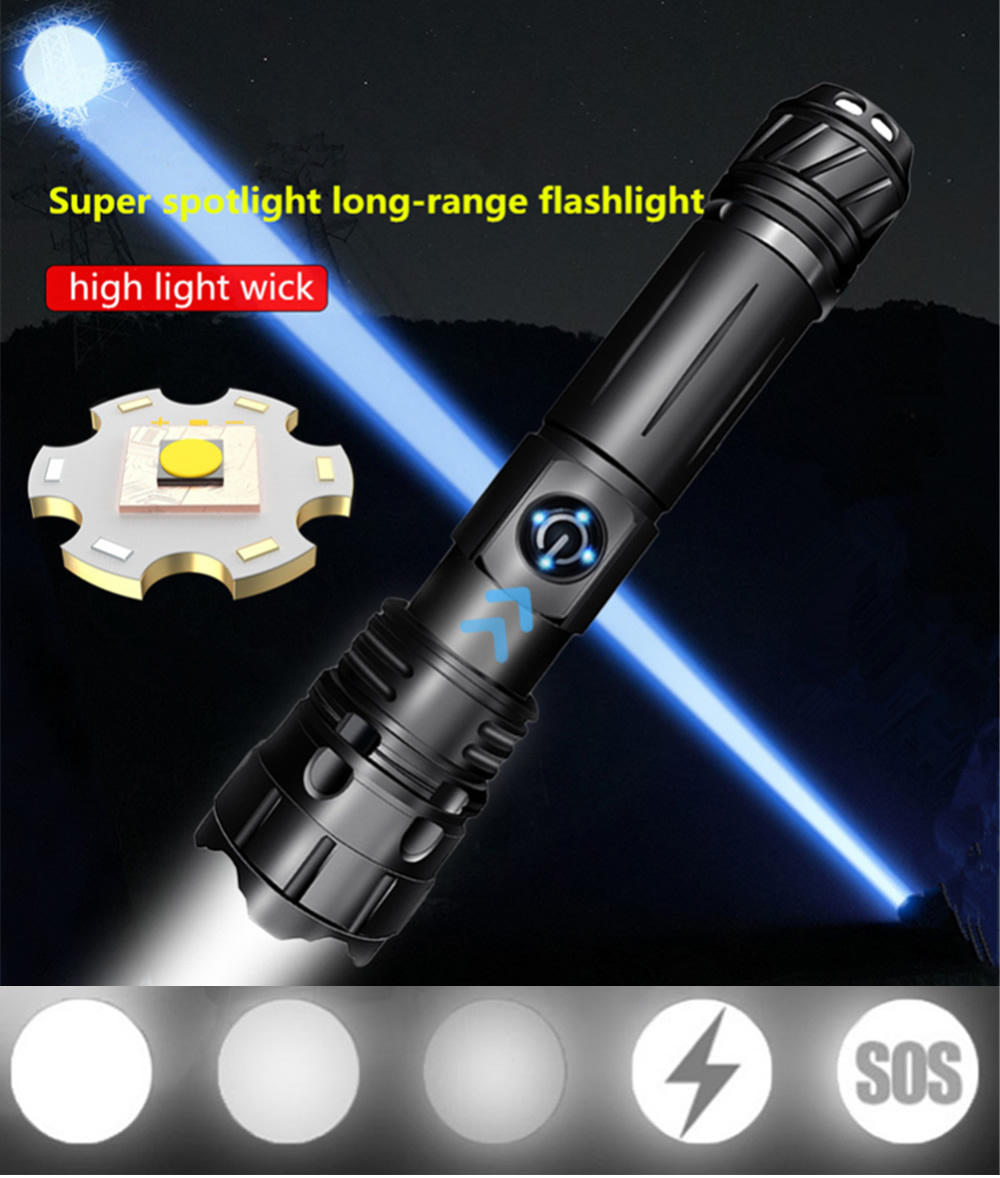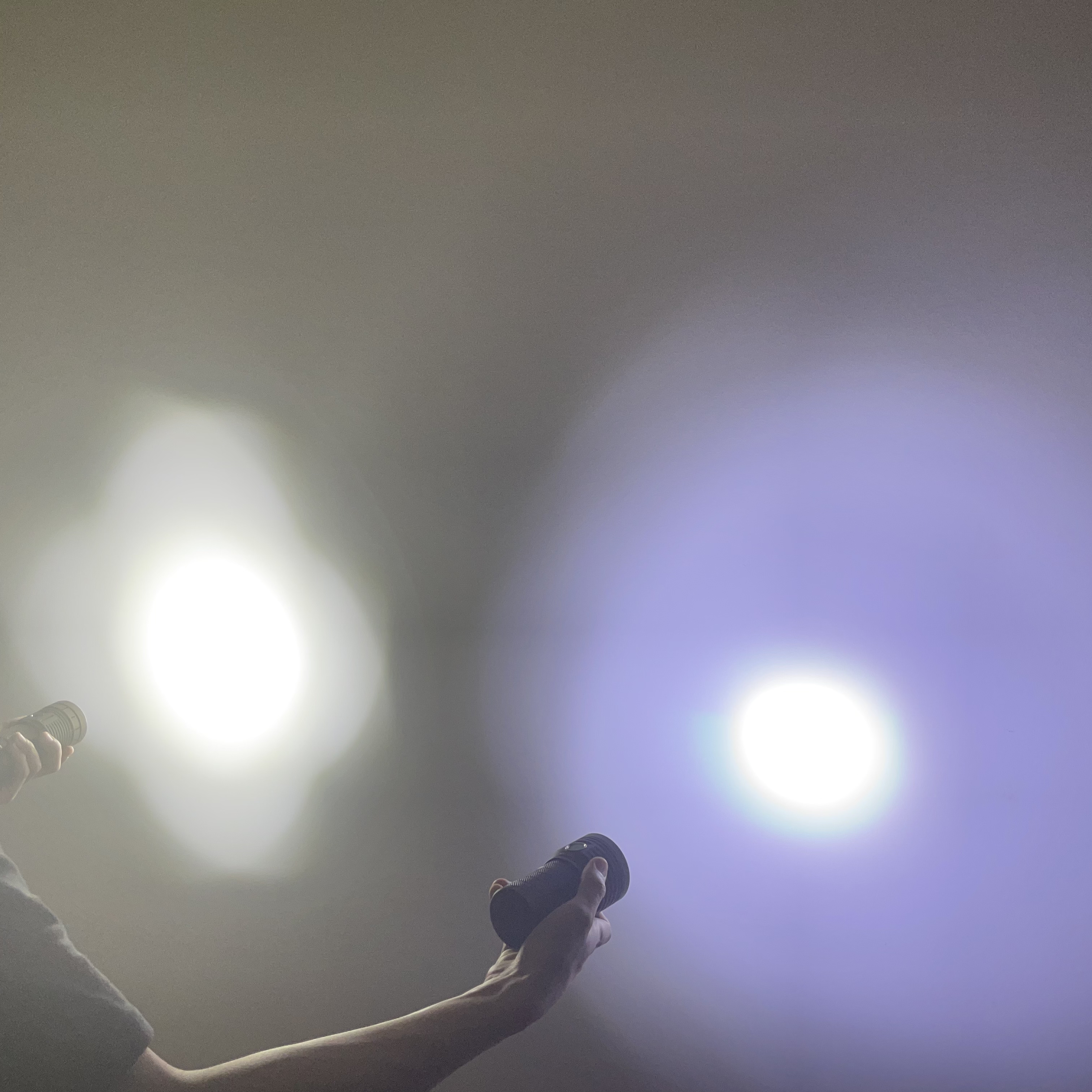Understanding the Flashlight Hot Spot and Beam Pattern

When you turn on a flashlight, the light it emits forms a pattern known as the flashlight beam. This beam consists of distinct parts, each serving a unique purpose. The hot spot, located at the center, is the brightest and most focused area. Surrounding it, the spill provides broader, less intense illumination. These elements work together to shape how effectively a flashlight performs in different scenarios.
Here’s a quick breakdown of key terms:
Term | Definition |
|---|---|
Hotspot | The brightest and most concentrated area of the beam, typically located in the center. |
Spill | The broader, less intense area surrounding the hotspot, providing wider coverage. |
Flood | A wide, diffused beam pattern ideal for broad illumination. |
Throw | A narrow, focused beam that can reach great distances, suitable for long-range illumination. |
Understanding these components helps you choose the right flashlight for your needs, whether for close-up tasks or long-distance visibility.
Key Takeaways
A flashlight beam has a hot spot, spill, and corona. The hot spot is the brightest part and good for focused tasks.
Flood beams light up wide areas, great for camping or big spaces. They let you see everything around you clearly.
Throw beams shine light in a narrow path, perfect for seeing far away. Use them for searching or exploring outdoors.
Hybrid beams mix flood and throw features, making them flexible for different jobs. They work well for both close-up and far-away tasks.
When picking a flashlight, think about its beam type, brightness, and strength. Look for things like different modes and water resistance to make it reliable.
Anatomy of a Flashlight Beam

The Hot Spot
Characteristics and role in beam focus
The hot spot is the brightest and most concentrated part of the flashlight beam. It sits at the center and provides focused illumination. This high-intensity light is created by the reflector, which directs the light into a tight, powerful beam. The hot spot is essential for tasks that demand precision, such as inspecting small details or lighting up distant objects. Its brightness ensures you can see clearly in situations where accuracy matters most.
The reflector and lens play a critical role in shaping the hot spot. The reflector focuses the light, while the lens refines its quality. Together, they ensure the hot spot remains sharp and effective. Without this concentrated area, the flashlight would lack the ability to provide targeted illumination.
How the hot spot impacts visibility
The hot spot significantly enhances visibility by delivering a focused beam of light. This feature is especially useful in low-light environments or when you need to illuminate a specific area. For example, if you’re hiking at night, the hot spot helps you see the trail ahead clearly. It also allows you to identify objects or hazards from a distance. The intense brightness of the hot spot ensures you can rely on your flashlight for high-intensity light when it’s needed most.
The Spill and Corona
Spill: Peripheral illumination and its importance
The spill surrounds the hot spot and provides broader, less intense illumination. This part of the flashlight beam ensures you can see your surroundings, not just the area directly in front of you. The spill is crucial for tasks that require awareness of a wider area, such as camping or working in a dimly lit room. It complements the hot spot by offering peripheral visibility, making the flashlight more versatile.
The spill is shaped by the reflector and lens, which disperse the light outward. This design ensures the beam covers a larger area without compromising the brightness of the hot spot. The combination of the hot spot and spill creates a balanced flashlight beam that meets various lighting needs.
Corona: Transition zone and its contribution to beam quality
The corona is the transition zone between the hot spot and the spill. It softens the edges of the hot spot, creating a smoother beam pattern. This zone enhances the overall quality of the flashlight beam by reducing harsh contrasts between the bright center and the dimmer spill. The corona ensures the light transitions seamlessly, making it easier on your eyes.
The corona also plays a role in improving the usability of the flashlight. It provides a gradual shift in brightness, which helps you adapt to different lighting conditions. Whether you’re using the flashlight for close-up tasks or scanning a larger area, the corona ensures the beam remains comfortable and effective.
Types of Flashlight Beam Patterns

Flood Beam
Wide-angle illumination and use cases
Flood beams provide a wide spread of light, making them perfect for illuminating large areas. Unlike the concentrated hotspot of a throw beam, the flood beam spreads light evenly across a broad space. This type of illumination works well for tasks where you need to see everything around you rather than focusing on a single point.
You’ll find flood beams especially useful in scenarios like camping, where lighting up an entire campsite is necessary. They also perform well in construction sites, garages, and worksites, offering extensive coverage for better visibility. In commercial settings, flood beams enhance safety by illuminating parking lots and landscapes. Their ability to provide broad illumination makes them a go-to choice for outdoor events and activities.
Throw Beam
Long-distance projection and applications
Throw beams focus light into a narrow, intense hotspot, allowing you to see far into the distance. This type of beam excels in long-range illumination, making it ideal for situations where you need to inspect or identify objects from afar.
Throw beams are commonly used in law enforcement for assessing situations from a distance. They also play a critical role in search and rescue operations, helping cover large areas effectively. If you’re managing land or livestock, a throw beam can help you monitor activity over greater distances. Additionally, these beams are invaluable for emergency signaling, increasing your visibility and improving your chances of being spotted during a crisis.
Hybrid Beam
Combining flood and throw for versatility
Hybrid beams combine the best features of flood and throw beams, offering both wide-angle illumination and long-range illumination. This versatility makes hybrid beams suitable for a variety of tasks. You can use them for close-up work while still having the ability to focus on distant objects when needed.
For example, a hybrid beam flashlight can illuminate a campsite while also providing a focused hotspot for spotting wildlife in the distance. This dual functionality ensures you’re prepared for any situation, whether you’re hiking, camping, or working outdoors. The combination of flood and throw capabilities makes hybrid beams a practical choice for those who need flexibility in their lighting tools.
Factors Shaping the Flashlight Beam
Reflector Shapes
Smooth reflectors and their effect on the beam
The reflector inside a flashlight plays a crucial role in shaping its beam. Smooth reflectors, as the name suggests, have a polished surface. This design focuses the light into a tight, concentrated beam. You’ll notice that smooth reflectors create a sharp hotspot with minimal spill. This makes them ideal for tasks requiring long-distance visibility, such as search and rescue operations or outdoor exploration.
However, smooth reflectors can sometimes produce light artifacts, which are irregular patterns in the beam. These artifacts may affect the overall beam quality, especially in situations where even lighting is essential.
Orange peel reflectors and their advantages
Orange peel reflectors, on the other hand, have a textured surface resembling the skin of an orange. This texture scatters the light, smoothing out the beam and eliminating harsh edges. You’ll find that orange peel reflectors produce a clean spill and an intense but edgeless hotspot. This makes them perfect for applications requiring even illumination, such as close-up work or general-purpose use.
The bumpy surface of these reflectors also helps reduce light artifacts, ensuring a more uniform beam. Whether you’re camping or working in a dimly lit area, orange peel reflectors enhance the usability of your flashlight by providing balanced lighting.
TIR Lenses
How TIR lenses shape the beam
Total Internal Reflection (TIR) lenses are another key component in shaping the flashlight beam. These lenses combine the functions of a reflector and a lens into a single unit. They direct and focus the light, creating a beam that is both efficient and precise.
TIR lenses excel at producing a well-defined hotspot with minimal spill. This makes them ideal for tasks requiring focused illumination, such as inspecting objects or navigating in the dark. Their compact design also allows for smaller flashlight sizes without compromising performance.
LED Output and Intensity
The role of LED brightness and placement
The LED is the heart of your flashlight. Its brightness, measured in lumens, determines the perceived intensity of the light. A higher lumen rating means a brighter light. However, the beam’s intensity also depends on how the LED is positioned and how the optical system focuses the light.
A narrow beam appears brighter because the light is concentrated in a smaller area. This is why flashlights with adjustable focus are so versatile. You can switch between a wide flood beam for general use and a narrow throw beam for long-distance tasks. The placement of the LED within the reflector or TIR lens ensures the light output and intensity meet your specific needs.
Choosing the Right Flashlight
Matching Beam Pattern to Purpose
Everyday carry (EDC) and general use
For everyday carry and general use, you need a flashlight that balances portability and performance. Compact size and lightweight design make it easy to carry in your pocket or bag. A flashlight with multiple lighting modes offers flexibility for different tasks, such as reading in low light or navigating dark spaces. Look for models with moderate light output and long battery life to ensure reliability throughout the day. Water resistance and impact resistance add durability, making the flashlight suitable for unexpected situations.
The Tradition Series flashlights are excellent for EDC. They provide a balance of candela and lumens, ensuring consistent illumination. These flashlights work well for industrial tasks, law enforcement, and general contracting. Their long regulated run times make them dependable for daily use.
Tactical, outdoor, and specialized needs
For tactical or outdoor activities, you need a flashlight with high performance and durability. A throw beam is ideal for long-distance visibility, while a hybrid beam offers versatility for both close-up and distant illumination. High-lumen flashlights, like those in the High Lumen (HL) Series, provide maximum brightness for clearing dark areas or lighting campsites. If you require long-range illumination, the High Performance, High Lumen (HPL) Series delivers optimal beam distance and enhanced output.
Consider features like strobe mode for signaling or disorienting threats, and rechargeable batteries for extended use. Water and impact resistance are essential for outdoor environments. A flashlight with these qualities ensures you’re prepared for emergencies, hiking, or search and rescue operations.
Practical Tips for Selection
Evaluating beam quality and preferences
When choosing a flashlight, focus on its usability and features. Ensure it’s easy to operate with one hand, even while wearing gloves. Select a size and weight that suits your intended use, whether for everyday carry or outdoor adventures. Evaluate the beam pattern to match your needs—flood beams for wide illumination or throw beams for long-distance tasks.
Check the flashlight’s brightness, measured in lumens, and its runtime on a full charge or fresh batteries. Durability is another key factor. Look for materials that can withstand impacts and water exposure, indicated by an IP rating. Additional features like multiple brightness levels, SOS mode, or strobe mode enhance versatility. By considering these factors, you can find a flashlight that meets your specific requirements.
Understanding the flashlight beam and its components, like the hotspot and spill, ensures you select the right tool for your needs. When choosing a flashlight, consider factors such as beam type, color temperature, and durability. Warmer color temperatures offer a natural glow, while cooler tones enhance visibility. Flood beams work well for camping, while spot beams excel in long-distance tasks. Adjustable beams provide flexibility for various activities.
For practical selection, prioritize features like multiple modes, safety locks, and durable materials. Opt for flashlights with a runtime of at least six hours for extended use. Lightweight designs suit backpacking, while rechargeable batteries save costs over time. Matching these features to your requirements guarantees a reliable flashlight for any situation.
FAQ
What is the difference between a flood beam and a throw beam?
Flood beams spread light across a wide area, making them ideal for close-range tasks. Throw beams focus light into a narrow, intense hotspot for long-distance visibility. You should choose based on whether you need broad illumination or the ability to see far away.
How does the reflector shape affect the flashlight beam?
Smooth reflectors create a focused, sharp hotspot with minimal spill. Orange peel reflectors scatter light, producing a softer, more uniform beam. Your choice depends on whether you need precise long-distance light or even illumination for close-up tasks.
Why is the hot spot important in a flashlight?
The hot spot provides the brightest and most focused light. It helps you see distant objects or perform tasks requiring precision. Without it, the flashlight would lack the ability to deliver targeted illumination in low-light conditions.
What are TIR lenses, and why are they used?
TIR (Total Internal Reflection) lenses combine the functions of a reflector and lens. They focus light efficiently, creating a precise beam with minimal spill. These lenses are perfect for compact flashlights and tasks needing focused illumination.
How do I choose the right flashlight for outdoor activities?
For outdoor use, select a flashlight with a hybrid beam for versatility. Look for features like water resistance, long battery life, and high lumens. A durable design ensures it withstands harsh conditions, while multiple modes provide flexibility for different tasks.
See Also
Choosing Between Zoomable Flashlights And Reflector Caps
Defining What Makes A Flashlight Tactical And Effective
A Complete Guide To Understanding Flashlight Lumens
